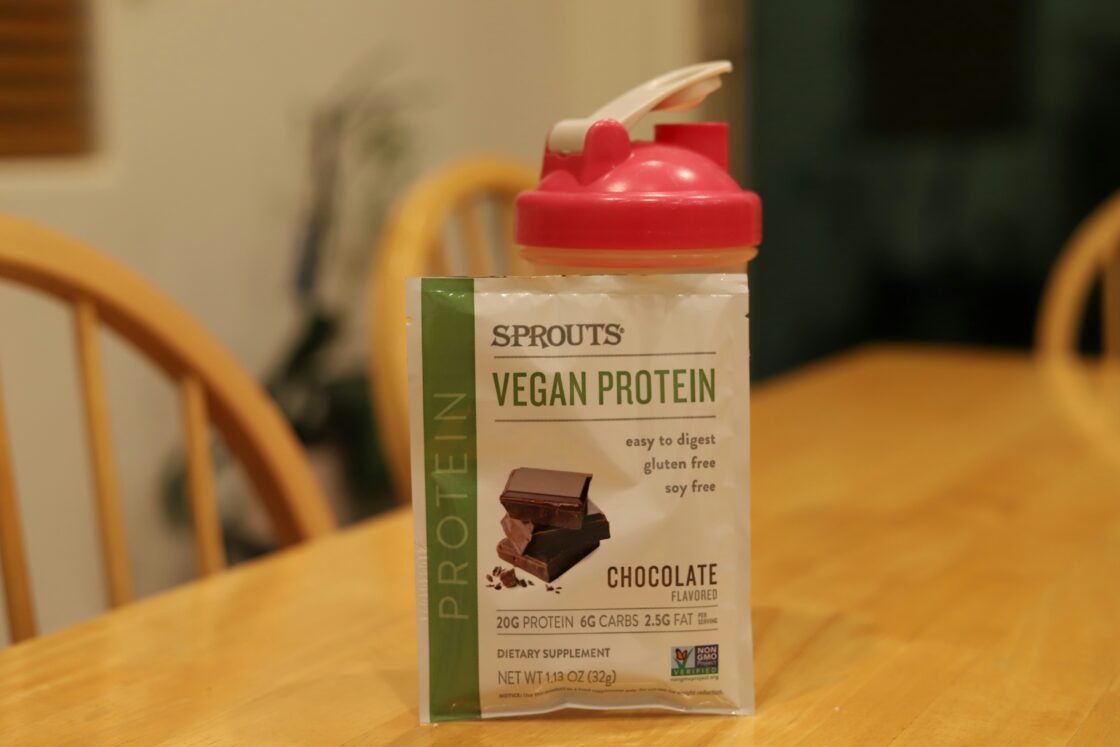
No one who buys a top-rated protein power expects they’re also sipping lead, BPA, and mercury. But a recent independent study showed that protein powder aficionados are getting way more endocrine disruption than they signed up for1. The Clean Label Project recently tasked an independent lab with testing 160 of the leading protein powders from 70 top-selling brands (over 80 percent of the market offering) for 130 different toxins. The findings were shocking, to say the least.
Most protein powders on the American market contained hazardous contaminants like mercury, BPA, and even arsenic. To top it all off, the worst offenders were plant-based and organic protein powders, more than 75 percent of which had measurable levels of heavy metals like lead.
“It’s horrifying,” said Jackie Bowen, MPH, MS, Clean Label Project executive director, “to think people who are trying to eat healthier by incorporating a nutritional protein powder supplement into their diet may actually be ingesting lead and BPA.”
Nearly Half of the Tested Protein Powders Contained Unsafe Levels of Heavy Metals
Forty-seven percent of the protein powders included in the test exceeded at least one state or federal regulatory safety threshold for toxic metals. Over a fifth of them contained levels more than twice as high as those allowed under California Proposition 65, a 1986 law requiring businesses to provide warnings about possible exposure to dangerous chemicals.
According to Dr. Joseph Mercola, Board Certified Family Medicine Osteopathic Physician (DO) and Author of Your Guide to Cellular Health, this is a major health risk.
“Even low levels of heavy metals like lead, cadmium, arsenic, and mercury can accumulate in your body over time, leading to severe health issues such as neurological impairment, organ failure, and an increased risk of cancer,” he said. ”The absence of federal regulations governing heavy metals in dietary supplements only exacerbates this problem, leaving consumers vulnerable to potential long-term health consequences.”
Three-Quarters of Plant-Based Powders Contained Loads of Lead

The protein in protein powder has to come from somewhere. In many cases, it comes from an animal source: whey and casein come from dairy; collagen is typically sourced from cattle, or egg. Plant-based alternatives may be made with all types of naturally rich sources of protein like soy, pea, or rice.
But while plant-based diets have been proven to be healthier for both people and the planet, the same can’t be said of plant-based protein powders, which were some of the worst contenders with regards to lead contamination. A whopping 77 percent of plant-based powders in the test exceeded Prop 65 levels for the heavy metal — three times more than whey- or collagen-based alternatives.
The effects of lead exposure are nothing to mess around with — even low levels of lead exposure can have devastating health effects. According to the National Institute of Environmental Health Services, blood levels below 10 µg/dl are associated with hypertension and increases in blood pressure2. Even half that amount may lead to decreased kidney function.
In addition to lead in protein powders, plant-based protein powders were found to contain mercury, cadmium, and arsenic. Sean Callan, PhD, director of operations and quality at Ellipse Analytics, the lab that performed the testing, says this, may be the result of contaminated soil at the source.
“This is especially true in the United States,” he said, “where there may be a higher incidence of heavy metals in the soil of some regions.”
Organic Protein Powders Were More Contaminated than Conventional
If consumers of organic protein powders thought they were in the clear, these results offer a rude awakening. Organic protein powders were even more contaminated than conventional alternatives, with 79 percent of organic protein powders exceeding Prop 65 acceptable levels for heavy metals.
Forty-one percent of organic protein powders tested over twice the Prop 65 recommended limit for lead, with three times as much as the conventional powders. They also contained twice the amount of cadmium, a cumulative nephrotoxicant. Even low levels of cadmium were shown to contribute to kidney dysfunction and decreases in bone mineral density3.
2020 research in the International Journal of Environmental Research and Public Health showed that low levels of cadmium exposure could also damage the liver and cardiovascular system and lead to adverse effects on both female and male reproduction4. Women naturally have a higher cadmium body burden than men, the study authors explained. Compounded with the substance’s effect on the skeletal system and hormones, this could increase the likelihood of developing osteoporosis.

Mercola found the higher presence of contaminants in organic powders “curious,” seeing as biosludge, synthetic fertilizers, and pesticides are not permitted in organic agriculture. He posited that this could stem from a range of factors, including soil that had already been contaminated prior to its conversion to organic farming.
“Additionally, the global ingredient supply chain often lacks stringent quality controls, allowing contaminants to slip through unnoticed,” he added. “Organic standards also vary from country to country, and organic fraud is big business. Put fraud and lack of quality controls together, and it becomes easier to see how this seeming paradox can occur.”
Chocolate-Flavored Options Were More Contaminated
Chocoholics may want to choose a cleaner chocolate source than cocoa-flavored protein powders. Chocolate powders contained four times more lead — and up to 110 times more cadmium — than vanilla alternatives, with 65 percent of chocolate protein powders exceeding Prop 65 levels for the heavy metal and 29 percent containing over twice the recommended limit.
This, Mercola said, stems from cocoa’s susceptibility to heavy metal accumulation. “Cocoa plants have a natural propensity to absorb metals like cadmium from the soil,” he said. This assertion was confirmed by a 2020 study in Science of the Total Environment showcasing the presence of cadmium in cocoa5.

“The regions where cocoa is predominantly grown, such as parts of South America, often have soils that are either naturally high in these metals or have been contaminated by industrial and/or agricultural activities,” Mercola added. “Moreover, the processing of cocoa can introduce additional contaminants if not managed properly.”
With all of these risk factors to consider, vanilla is definitely the safer choice.
The Silver Lining? BPA Levels Have Fallen
The dangers of BPA are well-established, with studies linking the chemical found in plastics and resins to hormone disruption, metabolic disease, and even cancer6. As a result, the industry has largely shifted away from using it, and BPA-free packaging is fairly widespread.
These industry-wide changes led to the one silver lining of the study: BPA was only present in three of the tested powders. This showed a marked improvement as compared to Clean Label Project’s 2018 study, where a whopping 55 percent of products contained BPA or BPS, a replacement for BPA that has proven even more dangerous than BPA7.
Choosing a Healthy Protein Source
If you do want to supplement your diet with protein, there are absolutely still ways to do that without consuming lead in the process. So what are healthy sources of protein you can substitute your usual powder for?

Protein Powder Brands You Can Trust
The study mentioned a few brands as cleaner options:
To these, Dr. Mark Hyman offered his own suggestions, recommending clean, grass-fed whey protein that’s third-party tested. Examples include:
- MT. Copra
- Pure Paleo
- Sprout Living
Protein Powders Are Not the Be-All and End-All
While protein powder is certainly a quick and easy way to add more protein to your diet, there are more natural ways to get the nutrition you need — without the endocrine-disrupting chemicals. “Skip the powders when you can,” Hyman suggested in an Instagram post. He recommended that people choose whole food proteins as alternatives to protein powder, like pasture-raised eggs, wild-caught salmon, grass-fed beef, and nuts and seeds instead.
These whole sources notably don’t contain additives like sugars, artificial sweeteners and artificial flavors, which Mercola noted are widespread in protein powders and can have negative repercussions on our health.
Shift the Conversation Away From Protein
Protein supplements represent a massive industry, with a market size of $11.36 billion in 2025 in the U.S. alone — and the protein powders segment held the largest share of the protein supplements market8. This surge represents widespread demand for fitness products, but also a newfound obsession with the macronutrient.

Protein is, of course, an essential building block of human tissue, contributing to reproduction, bone and muscle growth, and a healthy immune system. But these days, our protein obsession has gotten the better of us, leading most Americans to consume way more than we need — around twice the amount recommended in the federal dietary guidelines9.
“Clearly, protein is essential for health, but it’s important to strike the right balance,” said Mercola, who recommends using the formula of .8 grams of protein per pound of your ideal body weight to determine your optimal protein intake. Only about 15 percent of daily calories should come from protein, he said, and about a third should be in the form of collagen, such as bone broth or fatty fish. “Few Americans get anywhere near the amount of collagen required for optimal health,” he said.
In summary, while it’s admirable to want to supplement our diets with macronutrients, it’s best to try to do so with whole foods. When that’s not possible, do your research to find a clean product that meets your needs (without a side of heavy metals). And don’t get too focused on any single macronutrient over the bigger picture — chances are, you could be missing out on other nutrients that are just as important.
Sources:
- https://www.niehs.nih.gov/health/topics/agents/lead
- https://cleanlabelproject.org/wp-content/uploads/CleanLabelProject_ProteinStudyWhitepaper_010625.pdf
- https://pmc.ncbi.nlm.nih.gov/articles/PMC1247384/
- https://pmc.ncbi.nlm.nih.gov/articles/PMC7312803/
- https://www.sciencedirect.com/science/article/abs/pii/S0048969720311566
- https://pmc.ncbi.nlm.nih.gov/articles/PMC7460848/
- https://pmc.ncbi.nlm.nih.gov/articles/PMC7071457/
- https://www.instagram.com/p/DFKmhmEPpDn/
- https://www.precedenceresearch.com/us-protein-supplements-market
- https://www.nytimes.com/2017/07/28/well/eat/how-much-protein-do-we-need.html


